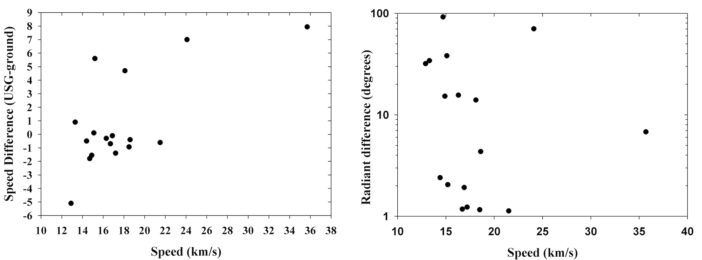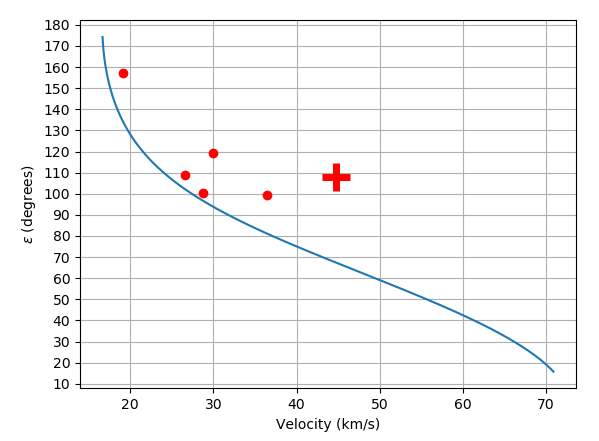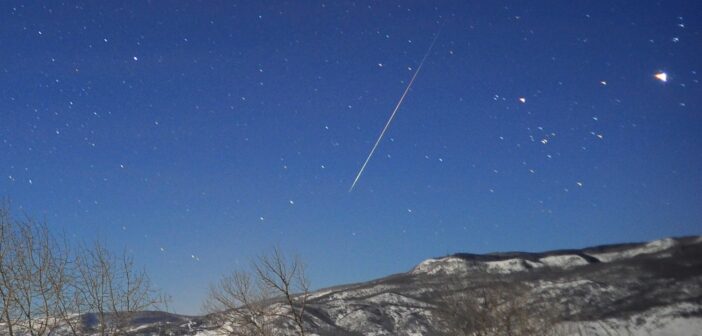Editor’s Note: Astrobites is a graduate-student-run organization that digests astrophysical literature for undergraduate students. As part of the partnership between the AAS and astrobites, we occasionally repost astrobites content here at AAS Nova. We hope you enjoy this post from astrobites; the original can be viewed at astrobites.org.
Title: On the Proposed Interstellar Origin of the USG 20140108 Fireball
Authors: Peter G. Brown and Jiří Borovička
First Author’s Institution: University of Western Ontario
Status: Published in ApJ
Since the unambiguous identification of ʻOumuamua, the first interstellar visitor to our solar system, popular interest in astronomy and astrobiology has exploded. Theories (however unlikely) that ʻOumuamua represented some artifact of an extraterrestrial intelligent civilization not only turned significant public attention to the study of small solar system bodies, but also that of so-called Unidentified Anomalous Phenomena (UAPs). Long speculated to be sightings of alien spacecraft, the study of UAPs is now being tackled by several groups, ranging from the Pentagon, to NASA, to private institutions. Perhaps the best-advertised of these is the Galileo Project, headed by Dr. Avi Loeb, lately Chair of Harvard’s Department of Astronomy, originator of the ʻOumuamua derelict spaceship theory, and second author of an article claiming the archival detection of an interstellar meteor (USG 20140108) from US government (USG) monitoring data.
ʻOumuamua’s Predecessor?
Most meteors we see come from orbits bound to the solar system. However fast these bolides (fiery meteors) appear and disappear in their starry streaks, they typically don’t fly fast enough to indicate unbound, extrasolar origins. USG 20140108 was originally detected by classified government sensors and released as part of the Center for Near-Earth Object Studies (CNEOS) Fireball Catalog, and its interstellar nature was proposed by Siraj and Loeb (2022) based on the government-measured velocity, about 45 km/s. The CNEOS data don’t come with uncertainties, so Siraj and Loeb rely on a Department of Defense statement that “the velocity estimate reported to NASA is sufficiently accurate to indicate an interstellar trajectory.” Armed with this letter, Siraj and Loeb confidently claimed the object to be interstellar in origin, and Loeb’s Galileo Project chartered an expedition to attempt to recover fragments of the bolide from the bottom of the ocean.
Independent Estimations
Rather than try to hunt down the original, classified source of the 2014 event, the authors of today’s article try to estimate the uncertainty on the bolide’s measured speed from other, independently observed fireballs. Aside from the inflammatory claims regarding its origin, USG 20140108 does stand out in the CNEOS catalog, with the second highest speed and sixth lowest altitude of peak brightness out of nearly a thousand recorded events. Independent estimates should help inform the precision of the CNEOS data and determine whether a proposed interstellar origin is likely.
To do this, the authors examined 17 other fireball events, all present in the CNEOS catalog but also independently observed by non-classified space- and ground-based cameras (a full list of these events and their references is present in Table 3 of the article). By comparing these independent events to the CNEOS data, the authors identified two critical parameters — speed and radiant direction (from which the meteor came) — that may be particularly unreliable in the CNEOS data. The 17 events span a decade in time, 20 km/s in speed, and were roughly evenly distributed across the sky.
As we see in Figure 1, as the bolide’s USG-reported speed increases, so does the difference between the USG-reported speed and independently measured speed. No clear speed-dependent trend is apparent in the radiant data, but the USG-reported and independently measured radiants can differ widely. Following these data, the authors predict that for the fireball’s measured speed of 45 km/s, there should be a measurement uncertainty of 10–15 km/s. They also note that given the range of radiant discrepancies, there may be up to a 30-degree error in the apparent radiant.

Figure 1: Speed (left) and radiant (right) differences between USG and independent sensing of 17 bolides plotted against USG-reported speed. [Brown and Borovička 2023]
Interstellar or Intrastellar?
So, armed with their new uncertainties, the authors compare USG 20140108 to other bolides in the catalog on supposedly unbound orbits. As seen in Figure 2, assuming the other CNEOS measurements have uncertainties comparable to the trends identified in the article, all the unbound bolides have significant chances of actually being on bound orbits. USG 20140108 is again the most extreme of these, but given the velocity and radiant errors estimated in the article, the authors conclude that the simplest answer is that USG 20140108 originated within our own solar system.

Figure 2: Radiant elongation versus velocity plot showing putatively unbound bolides in the CNEOS catalog. USG 20140108 is shown as the red cross. Unbound orbits are found to the right of the line and bound orbits are to the left of the line. [Brown and Borovička 2023]
Hard Rock or Heavy Metal?
While the reliability of the government measurements is the main focus of the article, the authors also used their analysis to reexamine the meteorite’s composition. Siraj and Loeb claimed that in order to produce the observed flashes and flares, the meteor must have had a metallic composition of anomalous strength, possibly indicating extrasolar material. If, in fact, the meteor’s speed was much slower (as the new wider uncertainties would allow for), then a stony meteorite is capable of producing the observed light curve.
Without invoking exotic materials or alien destinations, it appears USG 20140108 may just be yet another simple shooting star, burning brightly yet briefly. Articles like this exist in a long tradition of academic discourse, but few other topics draw as much public and private interest (both scientific and sensational). While we’ll almost certainly never know the bolide’s true provenance, the recently reported recovery of supposed fragments from the meteor (possibly in contravention of international treaties) means this result will definitely be critical to interpreting any new claims about its nature.
Original astrobite edited by Evan Lewis.
About the author, Yoni Brande:
I’m a fourth-year PhD candidate at the University of Kansas, working on exoplanet discovery and characterization. I primarily work with TESS transit data and Hubble Space Telescope exoplanet transmission spectroscopy data, and I’m also interested in enabling more collaborative science with open source astronomical software tools. When I’m not doing research or writing Astrobites, I can be found in a sci-fi streaming binge, running, lifting, cooking, or on Twitter @YoniAstro.

